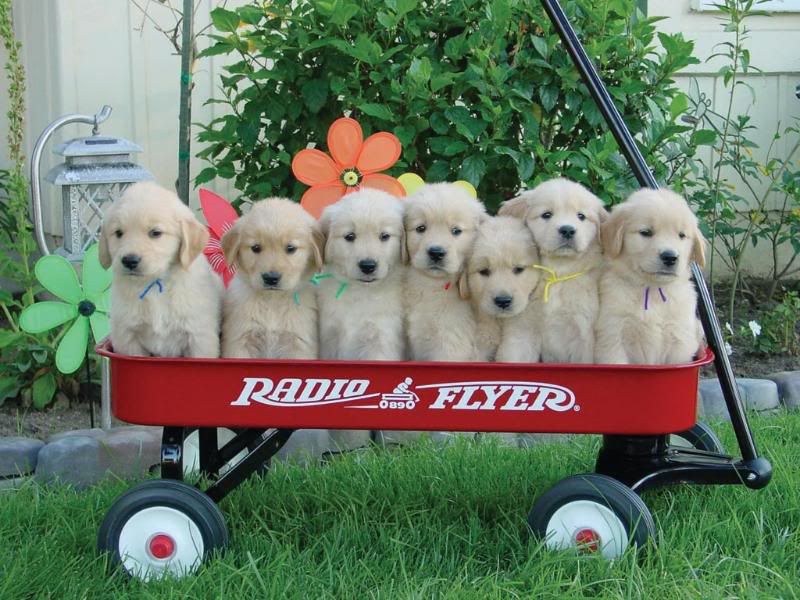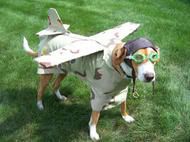

Photo Sharing - Video Sharing - Photo Printing I guess it was inevitable. Here I've been posting cats up one side and down another until I am blue in the face. Additional mixed metaphors will be preceded by a warning. Anyway, after the last cat thingie that I posted I realized that it was time to see about cats and dogs. And I am one of those that doesn't presuppose that the world is either cat or dog lovers. Actually, I think there are many who don't differentiate what they love..dey loves evryting! Sorry..just joking but what I mean to say is dogs return your love while cats in comparison are largely indifferent.. the below item comes from New Scientist.com
THE world is divided into "dog people" and "cat people", each passionately believing that their preferred pet is superior. Until a decade ago, there was very little scientific evidence either camp could muster to support its claims. Then animal behaviourists became interested in dogs and unleashed a pack of ingenious experiments testing canine capabilities and cognition. Recently, researchers have started doing similar work with cats. Could it be time for that showdown?

There are obvious pitfalls in trying to use science to resolve this perennial dispute. Every pet-owner knows their furry family member is special - a unique being with its own talents and foibles. Yet scientific research tends to look at species as a whole and deals in averages and trends when attempting to quantify their characteristics. Then there is the thorny issue of comparing two very different animals. Some might argue that the whole venture is doomed to failure, but here at New Scientist we like a challenge. So we have pitted cats against dogs in 11 categories. It's a winner-take-all competition with "best in show" being awarded to the pet that prevails in the most categories. Let the fur fly...
1. BRAINS
At 64 grams, the average dog brain is far bigger than its feline equivalent, which weighs in at a mere 25 grams. But then the average dog is much heavier than the average cat. If instead you measure brain mass as a percentage of body mass, cats win by a whisker.
Felophiles should not gloat yet. In general, smaller mammals have slightly larger brains relative to their body size than bigger ones. This means cats' brains are exactly the mass you would expect for their size, whereas dogs have slightly more upstairs than you would predict.
On size alone, then, the results are ambiguous. That is perhaps all to the good, because brain size is not a reliable measureof intelligence. In fact, if you want to assess smarts you are far better looking at behaviour than crude neuroanatomy - more on that later. However, there is one anatomical measure that gives a pretty good indication of information processing capacity: the number of neurons in the cortex, or executive brain. Here cats trounce dogs, with 300 million neurons compared with a piddling 160 million (Trends in Cognitive Science, vol 9, p 250).
WINNER: CATS
RUNNING SCORE: CATS 1 - 0 DOGS

2. SHARED HISTORY
Several research teams have compared DNA from dogs with that of grey wolves, their closest living ancestor, to try to pinpoint the date of domestication.
In the first study of this kind in 1997, Robert Wayne's team at the University of California, Los Angeles, came up with a date of 135,000 years ago. Since then, the entire dog genome has been sequenced and Wayne now believes his date may be a little premature. Nevertheless, given the discovery of archaeological remains of dogs dating from 31,000 years ago and the large divergence between dog and wolf DNA, he still suspects that domestication occurred at least 50,000 years ago.
Other DNA studies, however, suggest domestication could be more recent. The latest analysis, published in September by Peter Savolainen at the Royal Institute of Technology in Stockholm, Sweden, comes in at 16,000 years. It also points to an origin south of the Yangtze river in China and speculates that the first dogs were not working dogs, but destined for the dinner table (Molecular Biology and Evolution, vol 26, p 2849).
Our knowledge of feline domestication is also fuzzy. Evidence from ancient Egyptian burials and hieroglyphs indicates that cats were popular in homes from about 3000 BC onwards. However, the synergy with humans probably stretches further back. As soon as our ancestors began farming, their grain stores would have become magnets for vermin, and therefore cats. In 2007, comparisons of the DNA of wildcats from across the globe with that of domestic cats confirmed their origins in the Fertile Crescent east of the Mediterranean, the cradle of agriculture (Science, vol 317, p 519). What's more, cats seem to have wormed their way into our homes and hearts from an early stage, as evidenced by a 9500-year-old burial of a kitten alongside a human on Cyprus. While impressive, it still leaves Felix looking like a newcomer compared with Fido.
Cats seem to have wormed their way into our homes and hearts from an early stage
WINNER: DOGS
SCORE: CATS 1 - 1 DOGS
3. BONDING
The bond between a dog and its owner is remarkably similar to that between a parent and child. A secure baby behaves in a characteristic way in strange situations: it is courageous and happy to explore while its mother is around, becomes distressed when she leaves, will settle with a stranger in time, but has eyes only for mum when she returns.
Dogs put through the "strange situation" test respond in the same way. That is probably no surprise to dog people, who often cite unconditional love as their pet's more endearing quality. Are cats so very different?
Adam Miklosi from Eotvos Lorand University in Budapest, Hungary, whose group did the work with dogs, tried this experiment with cats - but they were having none of it. The lab setting was very upsetting and stressful for them, presumably because cats tend not to leave their territory. Nevertheless, Miklosi suspects that cats bond with their owners in much the same way that dogs do - if only he could persuade them to take the test.
Even the most besotted owner will admit that cats like their independence. Evolution is to blame. By nature, cats are loners. Dogs, meanwhile, are descended from pack animals and have an instinct to affiliate, and domestication has changed the focus of this instinct. Give a 4-month-old puppy the choice and it will choose a human companion over a dog. It seems they just can't help but love us.
WINNER: DOGS
SCORE: CATS 1 - 2 DOGS
4. POPULARITY
Arguably the ultimate test of whether an animal makes a good pet is how many people actually own them. Here cats are clear winners. Although worldwide figures are hard to come by, recent studies show that in the top 10 cat-owning countries there are almost 204 million felines. Pet pooches in the top 10 dog-owning countries number fewer than 173 million.
WINNER: CATS
SCORE: CATS 2 - 2 DOGS
5. UNDERSTANDING
Rico the border collie is famously able to understand over 200 words (Science, vol 304, p 1682). He's a clever boy, but even dogs with more limited comprehension can often recognise and respond to dozens of commands and requests for objects. And words are not the only channel of communication open to them.
Pooches can follow human pointing gestures, such as an outstretched finger or a nod of the head, to find food. That may not seem impressive, but chimps struggle to do it. Dogs also hold eye contact with humans - which wolves tend not to do - and use gaze alternation to bring objects to their owner's attention. They seem predisposed to inspect our faces for information, reassurance and guidance, according to Alexandra Horowitz who studies animal cognition at Columbia University in New York, and whose book Inside of a Dog was published in September.
However, Horowitz provides a cautionary tale for anyone tempted to overestimate their dog's level of comprehension. Her experiments revealed that a pooch's characteristic "guilty look" does not in fact signify an understanding of transgression, but is often simply produced in response to a scolding, regardless of whether or not it has been disobedient (Behavioural Processes, vol 81, p 447).
Cognitively speaking, cats are similar to dogs, says Miklosi, so you would expect them to have similar patterns of behaviour and abilities. A big difference is that they are not compliant or motivated, making them devilishly hard to work with. Nevertheless, Miklosi's team found that Felix is just as capable as Fido when it comes to following pointing gestures to find food. However, if the food is hidden and impossible to retrieve, dogs are far more likely to solicit help from their owners by gaze alternation, whereas cats mostly try in vain to obtain the reward for themselves (Journal of Comparative Psychology, vol 119, p 179). Understanding that humans can get you what you want may seem like cheating, but add to this the dog's superior vocabulary and eagerness to engage with its owner and it is only fair they win this one.

WINNER: DOGS
SCORE: CATS 2 - 3 DOGS
6. PROBLEM SOLVING
"Cats don't understand string theory" ran the headlines earlier this year after an experiment showed that if you offer kitty a choice between two pieces of string, one with a morsel of food at the end, they often fail to pull on the string attached to the reward (Animal Cognition, vol 12, p 739). Before canine-lovers crow... dogs do not pass the test either.
What's more, neither pet can use figurative cues to find hidden food. In other words, they don't understand X marks the spot. On the positive side, both are pretty good at retrieving bits of food from stashes placed at various distances from each other and from themselves. Although they employ slightly different strategies, their choices about the order in which they visit sites is efficient and logical (Behavioural Processes, vol 73, p 22).
Not much else is known of cats' problem-solving capabilities. Dogs have been subjected to far more testing, and have often failed to shine. In fact, there is a long-standing view that dogs are dunces compared with their wolf cousins, whose brains are a third bigger. One classic study showed that wolves learned to open a door with a complicated catch simply by watching another wolf do it, whereas dogs failed to master the catch even after years of seeing the door opened and closed.

But Miklosi, along with Jozsef Topal of the Hungarian Academy of Sciences in Budapest, suspected that a dog's partnership with its owner might be making it appear more stupid than it really is. The more intimate the bond, they reasoned, the more likely a dog is to relinquish its powers of independent thought and action to its owner.
Their suspicions were confirmed when they tested a variety of dogs on a task in which they had to pull on the handles of a plastic dish protruding from underneath a wire fence to retrieve some food. The most highly bonded dogs performed worst - but their success rate improved as soon as their owners encouraged them. The researchers conclude that dogs are not poor problem solvers, per se, but tend to favour a collaborative approach.
The full genius of this strategy is only revealed when you consider seeing-eye dogs. In their collaborations with blind owners, they often take the usual canine role of junior partner, but when the need arises they step in to solve problems their human cannot master. Chalk one more up to the small-brained wolf.
WINNER: DOGS
SCORE: CATS 2 - 4 DOGS
7. VOCALISATION
Shared ancestry means that all mammals tend to produce the same kinds of vocalisations to convey certain meanings. For example, they make sudden sounds with rising or rapidly fluctuating pitch to attract attention or demonstrate arousal, motivation or readiness. Both cats and dogs play on this mammalian mutual understanding in their vocal interactions with humans. Analysis of cat miaows reveals that they contain acoustic patterns that grab our attention. But the vocal repertoire of cats is quite limited and their calls tend to be idiosyncratic, so they are often interpretable only by their owners.
Dogs have far more vocal flexibility. They can vary the length, range, pitch, frequency modulation and tonality of their barks and they use this ability to produce characteristic barks in different situations. Even someone who has never owned a dog can make a good stab at telling, simply from its barks, whether it is lonely, aggressive or happy. Miklosi's group, who made this discovery, point out that other adult canids, including wolves, rarely bark. He suggests that during the course of domestication dogs may have evolved their elaborate vocal repertoire especially to communicate with us (New Scientist, 12 June 2004, p 52).
That's clever, but complexity is not everything. After all, no matter how much you love your pet, the barking or miaowing can get on your nerves. It looks as though cats may have found a way around this, though. A study published earlier this year reveals the subtlety with which they can use their crooning to ensnare us. By embedding an urgent high-frequency miaow into a blissed-out purr, they produce a sound that brings out our nurturing side. Karen McComb from the University of Sussex in Falmer, UK, who analysed these "solicitation purrs", suggests they work on a subliminal level in much the same way as a baby's cry, which has a similar frequency range (Current Biology, vol 19, p R507). For their guile, cats get the cream.
WINNER: CATS
SCORE: CATS 3 - 4 DOGS
8. TRACTABILITY
Dogs are easy to train because we have selected them to be so. They have evolved to fit into our homes and meet our needs, and they find it easy to learn and obey our rules. They are especially skilled at cognitive tasks that require cooperation and sharing information to achieve a goal.
While other animals such as chimps and dolphins learn by emulation - watching another individual carry out a task and then trying to achieve the same result - dogs learn in the same way as human infants. This process, called pedagogy, entails implicit teaching, with the dog attending to cues such as eye contact, gesture and vocalisation, and then directly imitating the actions of its master (New Scientist, 23 August 2008, p 33).
The most basic way to train a dog involves reinforcing the behaviours we want to encourage by giving Fido a titbit of food. Cats can be taught using rewards too. "They respond to stimulus and reinforcement," says Miklosi. But since no one has really tried training cats, we do not know the full extent of their abilities. Although there may be fewer ways to do it, they can probably achieve similar ends to dogs, Miklosi believes. "But dogs really want to do it. They are more interested and take it more seriously."
Besides, even without explicit instructions dogs naturally pick up the rules of domestic behaviour. This happens through play, according to renowned animal behaviourist Marc Bekoff of the University of Colorado, Boulder. He argues that the function of rough-and-tumble play is to develop a rudimentary sense of morality, and that such interactions with their owners allow dogs to test the limits of what is acceptable in a domestic setting. Dogs win paws down.
WINNER: DOGS
SCORE: CATS 3 - 5 DOGS
9. SUPERSENSES
Smell, sight and hearing are the most important senses for both cats and dogs. Having created endless breeds of dog to capitalise on their various perceptual talents, we should expect them to outperform the less highly selected cat - and they do show some quite amazing abilities. A bloodhound's nose, for example, contains 300 million smell receptor sites compared with just 5 million in humans. Its sense of smell is up to 100 million times more sensitive than yours.
However, while a dog's keen nose is legendary, cats are no mean sniffers either. In fact, because there is so much variability among breeds of dog, the average cat, with its 200 million smell receptors, actually has a more acute nose than the average dog.

Neither Felix nor Fido can match us when it comes to visual acuity, but their ancestry as nocturnal hunters has left them with some impressive visual abilities. Both have a faster "flicker-fusion rate" than we do, meaning the cells in their retinas take more snapshots of the world per second than ours, giving them superior sensitivity to movement. The main reason for this is that their eyes contain many more rod cells than cones, which also explains their poor colour vision. On the up side, rods are particularly good for seeing in low light. Here, once again, cats have the upper hand. Felix can see in light levels six times as low as we can, while Fido's limit is thought to be about five times ours.
Add hearing to the list, and cats score a hat trick. Their auditory range extends from 45 to 64,000 hertz, far wider than that of dogs at between 67 and 45,000 hertz.
WINNER: CATS
SCORE: CATS 4 - 5 DOGS
10. ECO-FRIENDLINESS
Cats love wildlife - in the UK alone they kill more than 188 million wild animals each year. But dogs are no bunny huggers. They have been implicated in the decline of the rare European nightjar, they disturb ground-nesting birds and, even when walked on a lead, their mere presence may reduce biodiversity (Biology Letters, vol 3, p 611).

The real difference in ecological impact comes in consumption. A medium-size dog's ecological footprint - the area of land required to keep it fed - is 0.84 hectares annually. You could run two SUVs on that and still have change. Even a toy dog such as a chihuahua has a footprint of 0.28 hectares per year. Meanwhile, your average cat's ecological pawprint, at just 0.15 hectares, looks positively virtuous (New Scientist, 24 October, p 46).
WINNER: CATS
SCORE: CATS 5 - 5 DOGS
11. UTILITY
Dogs can hunt, herd and guard. They can sniff out drugs and bombs and even whale faeces; they guide blind and deaf people, race for sport, pull sleds, find someone buried by an avalanche, help children learn and possibly even predict earthquakes. Cats are good if you have an infestation of rodents.

Perhaps that assessment is unfair, though. After all, we love our pets for other reasons. Cats are beautiful and soft, and stroking them has been shown to reduce stress. Then again, dogs are also good stress-busters: owning one can lower your blood pressure and cholesterol levels. What's more, Fido has other health benefits. Daily dog walks may be a chore, but they repay the effort, not just in terms of regular exercise, but also by providing immune-boosting opportunities for social contact with other dog walkers. That's why in a head-to-head contest of health benefits, it's dogs all the way (British Journal of Health Psychology, vol 12, p 145).
Daily dog walks may be a chore but they provide regular exercise and immune-boosting opportunities for social contact with other dog owners
WINNER: DOGS
SCORE: CATS 5 - 6 DOGS
So, at the risk of putting the cat among the pigeons, dogs come out on top. Unhappy with the final score? Think you have a better way to separate the dogs from the cats? Join our online debate at newscientist.com
http://www.newscientist.com/article/mg20427381.200-dogs-vs-cats-the-great-pet-showdown.html?full=true













